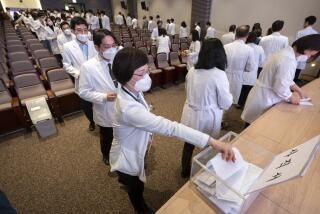Doctor Supply Grows Faster Than Patients : Boom could boost U.S. medical bills by $40 billion, but experts say health care will also improve.
- Share via
WASHINGTON — America is rapidly acquiring a batch of new doctors--quite possibly more than it can readily afford, medical economists say.
If current medical school graduation rates continue, the number of practicing physicians in America will climb to 484,345 by the turn of the century--a rise 22% faster than the population, researchers Kevin Grumbach and Philip Lee of UC San Francisco say.
Grumbach and Lee estimate that by the year 2000, the doctor-to-patient ratio will have risen to 176 physicians for every 100,000 persons, up from 144 for each 100,000 in 1986.
THE PROBLEM: The doctor boom is expected to add between $21 billion and $40 billion to what the nation spends for medical services--intensifying the tug-of-war between consumers and their employers, who are trying to keep health insurance costs down.
The notion that a sharply increased supply should push prices up, rather than down, may be difficult to grasp in any other business or industry, but economists say that in medicine, the laws of supply and demand appear to have been suspended.
The reasons are manifold: Increasing the number of doctors decreases the likelihood that greater use will be made of nurses, technicians and other less highly paid paramedicals. Moreover, greater numbers of physicians are becoming specialists. And the trend toward greater specialization--which in part reflects the explosion of medical knowledge and may indeed improve the quality of patient care--also adds to costs.
Not only are specialists paid more, but referral to specialists means more doctors are involved in an individual case.
Another factor is the physician’s role as gatekeeper in America’s health system. Beyond what a physician charges for his own work, he also is responsible for ordering other services such as tests, operations and hospital stays. The more doctors involved in a case, the more tests and other procedures are likely to be ordered.
Federal figures show that, although doctors only keep about 20 cents out of every dollar spent on health care in the United States today, they actually control how 80 cents of each dollar is allocated.
To a significant degree, the problem simply reflects a conflict between what may be desirable in economic terms and what is good in terms of medical care. Advances in technology have prompted doctors to make greater use of sophisticated equipment, and patients are medically the better for it in many cases. Economically, however, the advances cost more.
But there are other factors at work.
For one thing, some doctors order more tests to guard against possible malpractice suits.
And Dr. Sidney Wolfe says costs rise because patients do not have to worry about the bills--the government and insurance companies do it for them. Wolfe is director of the Public Citizen Health Research Group, a consumer advocate organization affiliated with Ralph Nader.
Eli Ginzberg, a health economist at Columbia University, agrees. “As long as there is money coming from all sources into the system, doctors can charge as much money as is in the system,” he says.
And Wolfe cautions that with more doctors now owning a share in new testing equipment, there is an increasing incentive for them to order extra tests.
THE OUTLOOK: C. John Tupper, president of the American Medical Assn., concedes that marketplace economics do not work in the field of medicine, but argues that part of the reason is that consumers do not want to shop around.
“If you have a child, and he or she is ill or injured, the first thing you say is: ‘I want the best care available,’ ” Tupper says. “You won’t go asking for the best price or (go) shopping for competitive rates.”
And the number of physicians clearly is growing. Since the early 1970s, the number of doctors practicing in the United States has increased by more than 70%, while the population as a whole has only increased by about 22%.
Although warnings about a possible surfeit led to a brief decline in medical school applications in the 1980s, enrollments have begun rising again.
More to Read
Sign up for Essential California
The most important California stories and recommendations in your inbox every morning.
You may occasionally receive promotional content from the Los Angeles Times.













